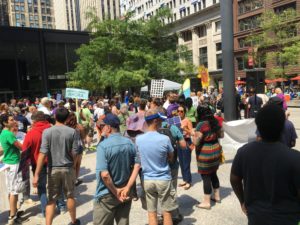Why I spoke at the Clean Energy Incentive Program Rally in Chicago
Last week, the U.S. Environmental Protection Agency (EPA) held a hearing in Chicago about the Clean Energy Incentive Program—a component of the EPA’s Clean Power Plan.
By Dick Breckenridge, Regional Program Manager for the BlueGreen Alliance in Illinois.

Citizens from all over Illinois came to Chicago to rally at an EPA hearing on the Clean Energy Incentive Program.
Last week, the U.S. Environmental Protection Agency (EPA) held a hearing in Chicago about the Clean Energy Incentive Program—a component of the EPA’s Clean Power Plan. The incentive program is designed to help low-income communities get access to renewable energy and energy efficiency. It is a great example of how a policy that reduces pollution and saves consumers money—for example, by making affordable multi-family housing more energy efficient—can also create good jobs.
I spoke at a rally in Chicago that took place during an EPA hearing on the incentive program to push for the Clean Energy Incentive Program to be designed to deliver good, lasting jobs and economic benefits to all communities—particularly those most impacted by pollution and climate change. The incentive program has matching funds that can be used by our state and others around the country to make sure those who are the most impacted by climate change have access to clean energy and energy efficiency savings, while also creating good local jobs and career paths in the efficiency sector.
The EPA itself has recognized that there have been historic economic, logistical, and information barriers to implementing demand-side energy efficiency programs in low-income communities. We can help fix that with a smart, strong Clean Energy Incentive Program. It should retain a core focus on delivering benefits to low-income households and communities. It should also jumpstart improvements to low-income residential and multi-family housing.
If structured and implemented well, housing efficiency projects implemented via the Clean Energy Incentive Program can mean big household savings on utility bills, as well as healthier indoor air quality. Plus, the incentive program can put a first rung on the career ladder, helping create quality jobs in local communities and statewide.
Energy efficiency is a major job generator. For example, a recent survey of clean energy jobs in Illinois, found almost 70,000 in the energy efficiency sector. These investments not only have the potential to increase overall jobs in this sector, but to help ensure impacted communities see good local jobs as a result. Retrofits using products without toxic chemicals also can improve health outcomes in communities that have long suffered a disproportionate increase in incidents of asthma and other diseases linked to the environment and air quality.
To accomplish both these goals, projects eligible under the Clean Energy Incentive Program should:
- Work with the building trades to develop a pre-apprenticeship program with targeted hire to connect workers from low-income communities to career paths.
- Adopt apprenticeship certification requirements for workers on CEIP projects in order to create more job openings for workers on a career path.
- Adopt labor standards such as prevailing wage and industry-recognized skill certifications,
- Establish contractor pre-selection based on responsible contractor criteria, with provisions to facilitate participation by minority contractors
- Require the use of healthy building products that meet standards for no or minimal “off gassing” of dangerous toxins to protect worker and public health.
Most energy efficiency jobs on the installation work are in the construction industry. Many more efficiency jobs are manufacturing and assembly jobs creating the building materials—like windows, insulation, smart lighting controls, and efficient heating and cooling systems. There are dozens of companies in Illinois manufacturing those products. Accordingly, preference for energy efficiency and clean energy products manufactured in the U.S. will help ensure a higher job creation and greater economic development overall.
My message in Chicago was pretty simple: Everyone deserves clean air, clean energy, and an energy-efficient home. Making low-income single-family and multi-family homes more energy efficient can put people to work, reduce pollution, and save people money today and tomorrow.